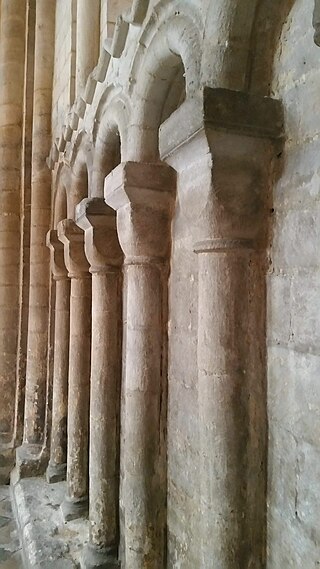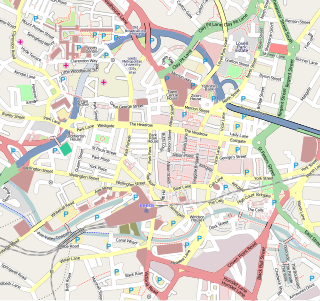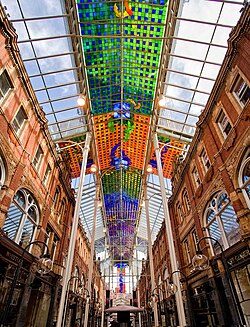
An arcade is a succession of contiguous arches, with each arch supported by a colonnade of columns or piers. Exterior arcades are designed to provide a sheltered walkway for pedestrians; they include many loggias, but here arches are not an essential element. An arcade may feature arches on both sides of the walkway. Alternatively, a blind arcade superimposes arcading against a solid wall.

State Library Victoria (SLV) is the state library of Victoria, Australia. Located in Melbourne, it was established in 1854 as the Melbourne Public Library, making it Australia's oldest public library and one of the first free libraries in the world. It is also Australia's busiest public library and, as of 2023, the third busiest library globally.

Cardiff city centre is the city centre and central business district of Cardiff, Wales. The area is tightly bound by the River Taff to the west, the Civic Centre to the north and railway lines and two railway stations – Central and Queen Street – to the south and east respectively. Cardiff became a city in 1905.

The Big City Plan is a major development plan for the city centre of Birmingham, England.

Francis Matcham was an English architect who specialised in the design of theatres and music halls. He worked extensively in London, predominantly under Moss Empires for whom he designed the Hippodrome in 1900, Hackney Empire (1901), Coliseum (1903) and Palladium (1910). His last major commission before retirement was the Victoria Palace (1911) for the variety magnate Alfred Butt. During his 40-year career, Matcham was responsible for the design and construction of over 90 theatres and the redesign and refurbishment of a further 80 throughout the United Kingdom.

The Queen Victoria Building is a heritage-listed late-nineteenth-century building located at 429–481 George Street in the Sydney central business district, in the state of New South Wales, Australia. Designed by the architect George McRae, the Romanesque Revival building was constructed between 1893 and 1898 and is 30 metres (98 ft) wide by 190 metres (620 ft) long. The domes were built by Ritchie Brothers, a steel and metal company that also built trains, trams and farm equipment. The building fills a city block bounded by George, Market, York, and Druitt Streets. Designed as a marketplace, it was used for a variety of other purposes, underwent remodelling, and suffered decay until its restoration and return to its original use in the late twentieth century. The property is co-owned by the City of Sydney and Link REIT, and was added to the New South Wales State Heritage Register on 5 March 2010.

Briggate is a pedestrianised principal shopping street in Leeds city centre, England. Historically it was the main street, leading north from Leeds Bridge, and housed markets, merchant's houses and other business premises. It contains many historic buildings, including the oldest in the city, and others from the 19th and early-20th century, including two theatres. It is noted for the yards between some older buildings with alleyways giving access and Victorian shopping arcades, which were restored in late 20th century. The street was pedestrianised in the late-20th century.

The Headrow is an avenue in Leeds city centre, West Yorkshire, England.

Trinity Leeds is a shopping and leisure centre in the city centre of Leeds, England, named after the adjacent 18th-century Holy Trinity Church. Developed by Land Securities and designed by Chapman Taylor, it opened on 21 March 2013, with over 130,000 recorded visitors on opening day.

Leeds city centre is the central business district of Leeds, West Yorkshire, England. It is roughly bounded by the Inner Ring Road to the north and the River Aire to the south and can be divided into several quarters.

The Central Milton Keynes shopping area is a regional shopping centre located in Milton Keynes, Buckinghamshire, England which is about 50 miles (80 km) north-west of London. It comprises two adjacent shopping centres, thecentre:mk which opened in 1979, and Midsummer Place opened in 2000. The centre:mk is anchored by John Lewis and Marks & Spencer. The complex is the 14th largest shopping centre in the UK, with the size of 120,773 sq metres.

Degraves Street is a pedestrian precinct and thoroughfare in the Melbourne central business district in Victoria, Australia. It is a short, narrow laneway that runs north–south from Flinders Street to Flinders Lane and is situated in-between Swanston and Elizabeth streets. Degraves, as the street is colloquially known, is famous for its alfresco dining options and because it epitomises Melbourne's coffee culture and street art scene. For these reasons it has also become a popular tourist destination.

Cardiff has many cultural sites varying from the historical Cardiff Castle and out of town Castell Coch to the more modern Wales Millennium Centre and Cardiff Bay. Cardiff was a finalist in the European Capital of Culture 2008.
The Tribeca Belfast development, formerly known as North East Quarter and previously Royal Exchange, is a planned £500 million development based in the north east of Belfast City Centre. It is a major mixed-use regeneration scheme, with a total area of 1.5 million sq ft (0.14 million m2) as of 2018. The development has generated controversy since its inception in 2003. Over the years, opposition has been levelled against its lack of care towards existing important built heritage, lack of integration with local small businesses and arts organisations and even its brand name, and much of its existence so far has been in the context of an arson attack on one of the existing buildings in 2004, while under the ownership of the developers.

Sir Brian Clarke is a British painter, architectural artist, designer and printmaker, known for his large-scale stained glass and mosaic projects, symbolist paintings, set designs, and collaborations with major figures in Modern and contemporary architecture.
Norte Shopping is the largest shopping center in the city of Rio de Janeiro and the second largest in Brazil. Established in 1986, the complex has undergone several major expansions. Notable for the programme of artworks in stained glass and mosaic designed for its 1996 expansion by architectural artist Brian Clarke, Norte Shopping has a constructed area of 245,028 m2 (2,637,460 sq ft).

The Melbourne central business district in Australia is home to numerous lanes and arcades. Often called "laneways", these narrow streets and pedestrian paths date mostly from the Victorian era, and are a popular cultural attraction for their cafes, bars and street art.

Buxton Crescent is a Grade-I-listed building in the town of Buxton, Derbyshire, England. It owes much to the Royal Crescent in Bath, but has been described by the Royal Institution of British Architects as "more richly decorated and altogether more complex". It was designed by the architect John Carr of York, and built for the 5th Duke of Devonshire between 1780 and 1789. In 2020, following a multi-year restoration and redevelopment project supported by the National Heritage Memorial Fund and Derbyshire County Council, The Crescent was reopened as a 5-star spa hotel.

The North Street Arcade is a 1930s Art Deco shopping arcade in the Cathedral Quarter of Belfast, Northern Ireland. It is the only example of a shopping arcade from this decade in Northern Ireland, and is one of only a handful left in the whole of Ireland or the UK. A Grade B1 listed building, it has been derelict since a fire in 2004.

























